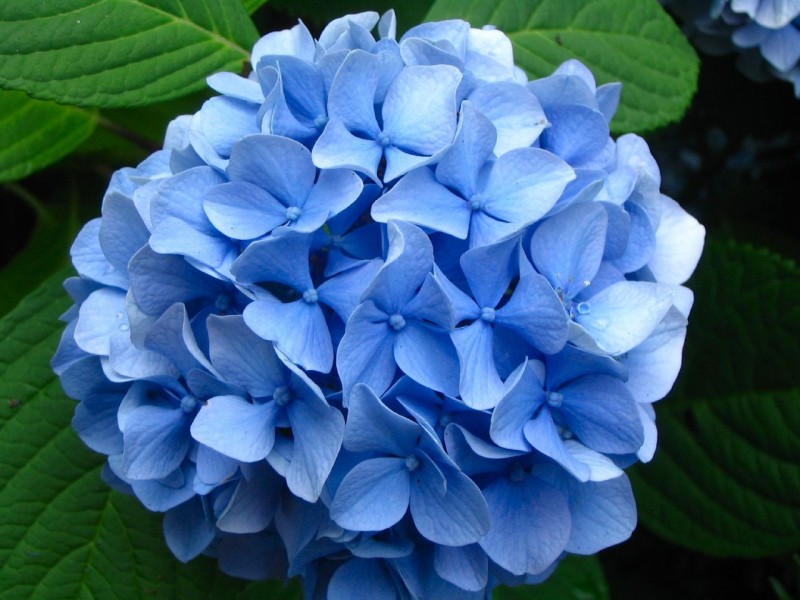Hydrangeas are a very popular landscape plant, prized for their abundant blooms and easy care. How you care for the hydrangeas in your landscape will depend on what type of hydrangea you have.
There are four categories of hydrangeas. These are Hydrangea macrophylla, commonly called Big Leaf, Mophead or Lacecap hydrangeas; Hydrangea arborescence, which includes “Annabelle” and its relatives, also known as Smooth hydrangeas; Hydrangea quercifolia, also known as Oakleaf hydrangeas; and finally, Hydrangea paniculata, which are commonly called PeeGee hydrangeas.
Big Leaf hydrangeas are some of the most popular hydrangeas in landscapes. Most of these bloom in July to August in either blue or pink, although a few varieties are white. Except for the white varieties, any of these can be grown as either blue or pink, depending on the acidity of the soil they’re grown in. We’ll talk more about changing the bloom color in another article.
If your Big Leaf hydrangea needs to be pruned, this should be done in early summer, before the flower buds are formed for the next season. These hydrangeas bloom on old wood, which is wood that was formed during the previous growing season. The flower buds are formed in August through October, so do any necessary pruning in the summer, prior to August. Prune out any dead wood each year, and after the plant has reached five years old about a third of the stems can be pruned back to the ground each summer to help revitalize the plant.
It’s best to plant Big Leaf hydrangeas in a spot where they can grow as large as they’d like. They can be cut back in midsummer if they’re getting too large for their space, but they’ll soon grow back to their large size.
Annabelle hydrangeas have large white blooms which often reach up to ten inches in diameter. A native plant of the eastern U.S., Annabelle prefers to grow where it can have morning sun and afternoon shade, or dappled shade all day. Hot afternoon sun will make Annabelle’s heavy blooms fade more quickly. Annabelle hydrangeas bloom from early summer through August or September.
Annabelle is a popular landscape shrub because it will bloom reliably even after heavy pruning or a severe winter. In the far north, the plant will die back to the ground each year, send up new growth in the spring and still bloom profusely. The blooms tend to be quite heavy, sometimes bending the stems to the ground. The stems may be staked to prevent this, or pruned to about 24 inches to help the stems become stronger and better able to support the heavy blooms. Annabelle hydrangeas bloom on new wood, and should not be pruned in the spring while they are preparing to bloom. They can be pruned any other time of year, but it isn’t necessary to prune Annabelle each year except for removing dead wood or branches that don’t contribute to a nicely shaped plant.
Oak leaf hydrangeas are also native to the U.S., and as their name suggests, they have large, deeply lobed leaves. The white blooms of oak leaf hydrangeas are beautiful in early to mid-summer, tending to turn pink as they age. Oak leaf hydrangeas also add color to the landscape in the fall as the large leaves turn brilliant red, burgundy, orange or yellow, especially if they receive some sun. These hydrangeas are more tolerant of sun and dry conditions than other types, but they will not tolerate wet feet. Oak leaf hydrangeas should be pruned at the same time and in the same manner as the Big Leaf hydrangeas.
PeeGee hydrangeas are very popular because they will grow in a variety of climates and are hardy up to zone 3. Like the oak leaf hydrangeas, PeeGee’s white blooms tend to turn pink as they age. PeeGees often grow very large, up to 8-10 feet tall and just as wide, and should be planted where they’ll have ample room. They do like some shade in very hot climates, and are tolerant of sun if they receive enough moisture. PeeGee may be pruned at any time except in midsummer when they are preparing to bloom, and they can also be pruned to a tree shape.
All hydrangeas will grow well and bloom with morning sun and afternoon shade. But they will not do well in heavy shade and wouldn’t be happy if planted beneath a shade tree. If you live in a cool northern state, your hydrangeas may grow well in more than a half day of sun, but if your landscape is hot and mostly sunny, you may want to stick to the PeeGee varieties. It may be difficult to grow hydrangeas in far southern areas that rarely see frost.
Hydrangeas don’t require much special care. You may want to give them a balanced, slow-release fertilizer once a year in late spring to keep them happy. Spread the fertilizer under the plant, but not right next to the trunk, and remember that not enough fertilizer is always better than too much.
By Kathy Anderson
Kathy Anderson has been an avid gardener for many years and has grown tomatoes by the acre, along with many other vegetables, flowers and landscape plants. Kathy recommends http://www.freeplants.com as a great place to learn more about gardening and more articles provided by http://gardening-articles.com.
